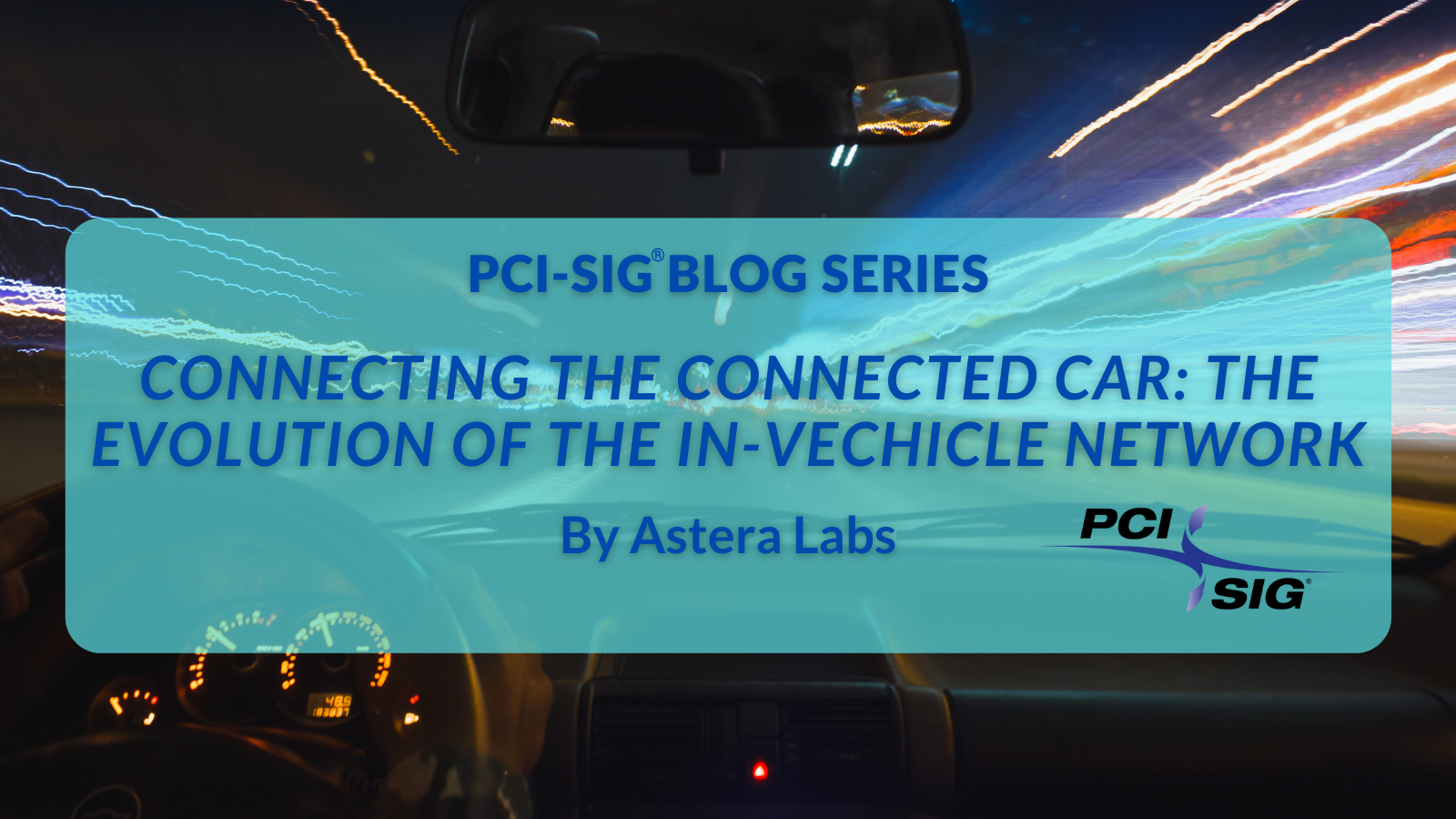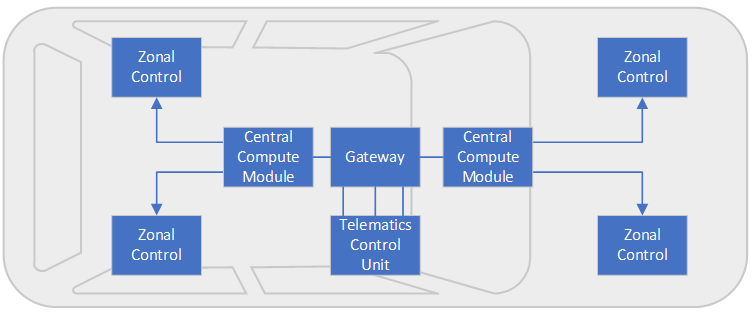Connecting the Connected Car: The Evolution of the In-Vehicle Network

By: Hope Bovenzi, Strategic Marketing, Astera Labs
For over a decade, the car has seen an accelerated evolution. The automotive industry has moved away from building a computer within a car to building a car around a computer – so much so that the car has shifted from a handful of electronic control units (ECUs) within a vehicle in the early 2000s to hundreds in modern vehicles. Simply integrating more computers into a car is no longer sustainable and connectivity across domains must be streamlined. The era of zonal architectures is here but that means mass data transfer throughout the car is just getting started.
A key ecosystem impacted by this evolution is the In-Vehicle Network. The In-Vehicle Network allows OEMs to cope with the volume of data that needs to be transferred and stored around the car. In fact, vehicle systems are approaching 1TB of data storage needed to properly operate. These separate domains in the current vehicle architecture may communicate within themselves today, however, domains must be able to talk to one another as complexity of the In-Vehicle Network increases to support new capabilities.
Interconnect technologies such as the PCI Express® (PCIe®) architecture—originally developed for PC, industrial and enterprise applications— are being adopted for new verticals like automotive, and we anticipate that PCIe technology will play an important role in the overall connected car story to meet the growing needs of mass data transfer.

Figure 1 Example Zonal Control Architecture
Before diving into how best to connect the connected car, let’s answer a few questions about what’s driving this need in the first place and how these trends are impacting the infrastructure of the car.
Electrification
With an eye on combating global warming, there is a universal movement to reduce fossil fuel usage. Activists, consumers, and regulatory bodies alike are putting pressure on OEMs to reduce auto emissions that contribute to 28% annual greenhouse gases in the United States alone. Because of this, OEMs are increasing the percentage of electric vehicles in their fleets, with some OEMs pledging full electrification within the next few decades.
For the In-Vehicle Network, battery management for electrification must connect to multiple domains for range, location, and trip information. Calculating the range of vehicle, one must take into account distances, energy output across that distance, and be able to communicate that information back to the driver via the trip planner of the vehicle’s infotainment system.
Connectivity
The automotive industry has not shied away from the “Internet of Things” trend and consumers more or less expect greater connectivity in the car as they do from their phone and smart home assistants. The need for information on demand and the want for consumable entertainment has driven the expectation of seamless connectivity transition from home to car to work.
Businesses have also taken advantage of greater levels of connectivity to and around the car. Connectivity has provided companies with new business opportunities such as mobility as a service, fleet management, and other Vehicle-to-X (V2X) applications.
Since the early 2000s, the onset of emergency calling (eCall) capabilities and legislation, cars have increasingly incorporated some sort of wireless connectivity device (previously a cellular modem). Now, with the movement of data between the cloud to the car, previously untapped opportunities are now available for mobility-as-a-service businesses, fleet management in commercial vehicles (such as tracking location, vehicle health monitoring, mobility data of fleet vehicles), but also Vehicle-to-X in consumer vehicles. Using Vehicle-to-cloud (a subset of Vehicle-to-X) as an example, OEMs can save money on recalls by doing remote software updates instead of having to bring cars into dealerships. This means, however, that not only does there have to be connectivity from the cloud to the car, but there must be higher degrees of inter-domain connectivity in order to do a software update “remote” domain within the car.
Autonomy
Autonomous vehicles aren’t a sci-fi, futuristic pipe dream but more prevalent than most people realize. With a spectrum, or levels of autonomy, ranging from 0 to 5, there are more “autonomous vehicles” on the road than meets the eye. Typically, new vehicles are in the level 1 to level 2.5 autonomy while autonomous taxis are in development with level 5 systems. Believe it or not, autonomous systems provide significantly safer experiences compared to an unassisted human, whether it’s a driver assist function or the elimination of the driver all together.
One of the primary factors propelling change to the In-Vehicle Network is the Advanced Driver Assistance Systems (ADAS). Reliable data communication has become even more important for systems to follow functional safety standards (ISO-26262) as autonomy levels increase. But furthermore, LiDAR, Radar, and camera inputs must be positioned all around the car, sensor aggregation needs continuously increase, and transferring that sensor information to be processed requires real-time responses with highspeed, reliable, low latency data communication.
Challenges within the In-Vehicle Network
From OEM to OEM, the In-Vehicle Network produces its own set of unique challenges. Older OEMs have had to evolve with the market from functional ECUs to domain controllers to zonal control, which creates a complex entanglement of cabling, cost, and weight. Newer OEMs have the benefit of building a car from the ground up but choosing the right highspeed link for data transfer is no easy feat due to the lack of standardization.
OEMs, new and old face a variety of challenges:
- There is a wide variety of types of links to consider from CAN, LIN, FlexRay, SerDes, MOST, PCIe technology and Ethernet.
- Not only is there a wide variety of protocols, but with the trends towards electrification, connectivity, and autonomy, data needs to have high bandwidth, low latency and able to repeatedly handle a high volume of data.
- Data transfer must be reliable and robust, despite Electromagnetic Interference (EMI), temperature variations, and vibrations.
- The In-Vehicle Network contributes to a significant portion of the vehicle’s weight so interconnectivity must be lightweight and small on top of being robust and reliable.
PCIe Architecture Connectivity– A Key Cog in the Future In-Vehicle Network
Although we can’t be sure how the In-Vehicle Network will continue to evolve, now is the time to redefine its future connectivity infrastructure. Automotive OEMs face a variety of challenges with ever-increasing amounts of data that needs to be robust despite environmental challenges in the car while also trying to reduce weight and size of interconnectivity. We also know that based on the trends we see in the market regarding electrification, connectivity, and autonomy, the In-Vehicle Network must cope with large amounts of data that will need to be reliably, safely, and securely transferred to and around the vehicle.
Interconnect technologies such as PCIe architecture will play an important role in the overall connected car story to meet the needs of mass data transfer within the In-Vehicle Network. We have recently seen a similar evolution of increased data rates and design challenges in data centers, where PCIe technology has significantly advanced the industry via higher bandwidths and lower latencies. Although data rates in the automotive world are significantly slower than those in data centers, the automotive industry can benefit greatly from established connectivity experts like those involved in the PCI-SIG®.
In fact, PCIe technology is already making inroads into the automobile as highlighted in a recent PCI-SIG blog, “Life in the Fast Lane: PCI Express® Technology in Automotive.” Today, PCIe architecture is being leveraged to connect ADAS, 4G/5G enabled Telematic Control Units, and infotainment systems – all of which are key In-Vehicle Network solutions that enable the automotive trends like greater connectivity and autonomy. In addition, PCIe technology is well-suited to serve the emerging interconnectivity needs of advanced In-Vehicle Network infrastructure of the future given its low latency capabilities, established roadmap of continuous bandwidth increases, and wide-ranging, robust ecosystem of existing devices and tools.
PCI-SIG invites members to join the new PCI-SIG Automotive Task Force to fully comprehend the benefits of PCIe technology and help chart the future of In-Vehicle Network infrastructure.
